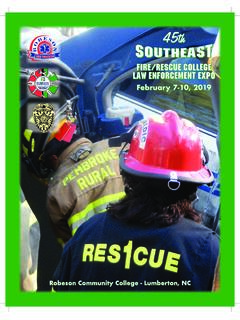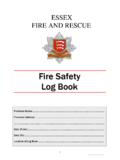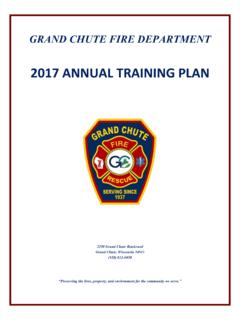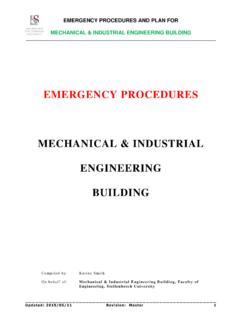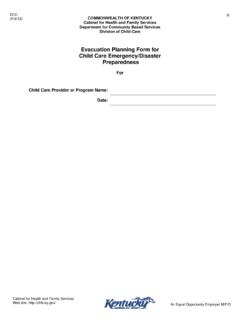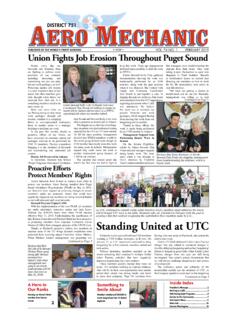Transcription of Attendance management in the Fire and Rescue Service
1 Executive Health and Safety Attendance management in the fire and Rescue Service Managing sickness absence and managing and supporting Attendance Prepared by the National Centre for Social Research (NatCen) for the Health and Safety Executive and Communities and Local Government (CLG) 2008 RR632 Research Report Executive Health and Safety Attendance management in the fire and Rescue Service Managing sickness absence and managing and supporting Attendance Clarissa Penfold, Jane Lewis & Rosalind Tennant National Centre for Social Research (NatCen) 35 Northampton Square London EC1V 0AX This study was commissioned by the Health and Safety Executive and the Department for Communities and Local Government (DCLG), and carried out by the National Centre for Social Research. It examined policy and practice in managing sickness absence within the fire and Rescue Service .
2 The aim of the study was to understand: n the nature of current policies and practices; n views and experiences of policies and practices among different types of staff; n the degree to which policies and practices reflect recent recommendations; n barriers and facilitators to adopting recommended practices; and n practices that are considered useful and how policy and practice in Attendance management might be improved. This report and the work it describes were funded by the Health and Safety Executive (HSE) and the Department for Communities and Local Government (DCLG). Its contents, including any opinions and/or conclusions expressed, are those of the authors alone and do not necessarily reflect HSE or the Department for Communities and Local Government (DCLG). HSE Books Crown copyright 2008 First published 2008 All rights reserved.
3 No part of this publication may be reproduced, stored in a retrieval system, or transmitted in any form or by any means (electronic, mechanical, photocopying, recording or otherwise) without the prior written permission of the copyright owner. Applications for reproduction should be made in writing to: Licensing Division, Her Majesty s Stationery Office, St Clements House, 2-16 Colegate, Norwich NR3 1BQ or by e-mail to ii Contents Acknowledgements .. vii Introduction (Chapter 1) ..ix Study aims and objectives ..ix Study design and conduct ..ix Analysis and reporting of Report Attendance management in context (Chapter 2) ..x Governance arrangements for fire and Rescue services ..x Case study services sickness absence performance ..x Overarching factors for successful Attendance Managing sickness absence (Chapter 3)..xi Going off sick.
4 Xi Contact during sickness absence ..xi Role of occupational health during sickness Financial Managing the return to Managing Attendance (Chapter 4).. xiii Return to work interviews .. xiii Trigger point Redeployment, retirement, capability proceedings and Supporting Attendance (Chapter 5) .. xiv Welfare, counselling and trauma Fitness, health screening and health promotion ..xiv Use of Discussion of findings (Chapter 6).. xiv Overarching factors for successful Attendance An holistic approach to Attendance Conclusions ..xv 1 INTRODUCTION .. 1 Study aims and Study design and conduct ..1 Sample selection and 2 Case study Service selection .. 2 management and occupational health staff sample .. 2 Sample of employees with experience of sickness absence .. 3 Conduct of 5 Analysis and reporting of Report structure.
5 6 2 Attendance management IN 6 Governance arrangements for fire and Rescue services ..7 Case study services sickness absence Overarching factors for successful Attendance management ..9 Effective use of performance management 9 Strategic prioritisation of Attendance 10 Devolved responsibility for Attendance Chapter 3 MANAGING SICKNESS ABSENCE .. 14 Going off sick ..14 Contact during sickness absence ..14 iii Contact with line managers .. 14 management 14 Staff perspectives .. 16 Contact with peers and senior managers .. 18 Role of occupational health during sickness Occupational health arrangements .. 18 Perceived advantages of an in-house occupational health 19 Perceived advantages of a contracted-out occupational health Service ..19 Contact with occupational 19 management 19 Staff perspectives.
6 20 Other Funding for private treatment .. 21 The fire Services National Benevolent 22 Financial provision ..22 Managing the return to Influences on the timing of returns to Planning returns to work .. 23 Phased returns and modified 24 Availability of phased returns and modified Identifying suitable roles for operational firefighters .. 25 Scope to remain with the watch and shift .. 26 Involvement of occupational Managing progression to usual duties .. 28 Issues for retained 28 Chapter 4 MANAGING Attendance .. 30 Return to work interviews ..30 management 30 Staff perspectives on return to work 32 Trigger point reviews ..33 Trigger point levels .. 34 Identification of employees requiring trigger point 35 Trigger point policy and training .. 35 Conduct of trigger point Redeployment, retirement, capability proceedings and Redeployment and retirement.
7 37 Capability and dismissal .. 39 Chapter 5 SUPPORTING 41 Welfare, counselling and trauma support ..41 Welfare and 41 Trauma support .. 41 Fitness, health screening and health promotion ..43 43 Health 44 Health promotion .. 44 Use of Chapter 6 DISCUSSION OF 46 Overarching factors for successful Attendance management ..46 An holistic approach to Attendance management ..46 Conclusions ..47 iv APPENDIX A CASE STUDY Service RECRUITMENT APPENDIX B RESPONDENT RECRUITMENT DOCUMENTS .. 53 APPENDIX C TOPIC 64 v vi Acknowledgements We are very grateful to the five case study services who agreed to participate in this research and would like to extend our deepest appreciation to all staff involved for their help, particularly those who gave their time to be interviewed. We would also like to thank Laura Smethurst at the Health and Safety Executive, Mark Dunn from Communities and Local Government, and Chris Enness and Paul Hill of the Chief fire Officers Association for their assistance and advice during the course of the research.
8 Clarissa Penfold Jane Lewis Rosalind Tennant National Centre for Social Research vii viii SUMMARY Introduction (Chapter 1) Study aims and objectives This study was commissioned by the Health and Safety Executive and Communities and Local Government, and carried out by the National Centre for Social Research. It examined policy and practice in managing sickness absence within the fire & Rescue Service . The aim of the study was to understand: the nature of current policies and practices; views and experiences of policies and practices among different types of staff; the degree to which policies and practices reflect recent recommendations; barriers and facilitators to adopting recommended practices; and, practices that are considered useful and how policy and practice in Attendance management might be improved. Study design and conduct The study used qualitative research methods to allow detailed exploration of policies and practices from a range of different perspectives.
9 Five case study services were selected to be broadly representative of all fire and Rescue services. The selection comprised one Service from each of the five different fire & Rescue Service family groups . The services selected also had different levels of short and long term sickness absence, including two with improved sickness absence performance between 2000 and 2005, and different governance arrangements. Across the case study services, 35 interviews were carried out with: strategic managers (chief fire officers, assistant chief fire officers, and directors of human resources); members of the occupational health team or Service ; and, line managers of operational staff (including retained staff), fire control and support staff. In addition, 30 interviews were conducted with employees with experience of sickness absence. An initial sample of employees was selected and invited to take part in the research.
10 A short telephone screening exercise was conducted with those who agreed to take part, and participants were selected to ensure diversity in employee group, sex, age, pattern of absence, health condition and whether or not they had returned to work. Interviews were carried out between March and June 2007, on fire and Rescue Service premises in the case of managers and occupational health staff, and at employees homes in the case of employees. Analysis and reporting of findings Interviews were digitally recorded, transcribed verbatim and analysed using Framework which involved summarising data under key themes. The report presents key findings from across the case study services, without the use of numbers or any indication of prevalence (since the qualitative sample is non-representative). The report does not discuss the case study services separately, rather it highlights key ix issues and differences, where these were evident in the data, in Attendance management practices.










